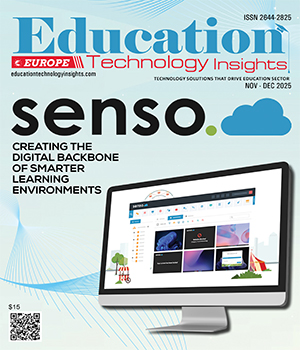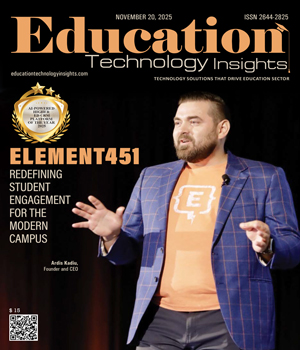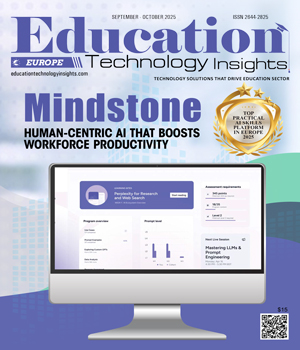THANK YOU FOR SUBSCRIBING
Be first to read the latest tech news, Industry Leader's Insights, and CIO interviews of medium and large enterprises exclusively from Education Technology Insights
Transforming a University into a Data-Rich, Literate Organisation: Reflections on the University of Law's journey
Andy Ramsden, Director of Technology Enhanced Teaching and Learning and Learning Analytics, The University of Law
 Andy Ramsden, Director of Technology Enhanced Teaching and Learning and Learning Analytics, The University of Law
Andy Ramsden, Director of Technology Enhanced Teaching and Learning and Learning Analytics, The University of LawAs with many institutions, the University of Law is on a transformational journey with its academic model. The starting point has been to articulate a new vision post COVID.
This discussion explores the steps we took to operational use this vision in terms of implementing Learning Analytics.
We adopted a five-step approach;
1. Articulate a vision for Learning Analytics within the broader vision of the academic model.
2. Assess our institutional readiness for implementing Learning Analytics
3. Write a Learning Analytics Adoption Plan
4. Implement the Adoption Plan
5. Continually improve based on feedback and evidence.
We positioned a vision for our use of Learning Analytics in our "Principles and Purposes of Learning Analytics" document. This outlined how we would use learning data to improve the student learning experience and outcomes.
The institutional readiness assessment combined a broader eMaturity model, with specific reference to Learning Analytics.
The findings highlighted strengths in terms of technical infrastructure, policy and processes. While, evidencing the need to improve the "people pillar" for high levels of adoption. The University of Law is fortunate to have three sector-leading analytics platforms, including SolutionPath. SolutionPath provides an understanding of student engagement across all aspects of academic learning. It provides real-time insight dashboards that help personal tutors proactively identify disengaged students and offer the right support to the right student at the right time.
The readiness assessment provided the priorities within the Adoption Plan. The Adoption Plan drew on good practices from across the HE sector and our software providers. For instance, we benchmarked our plan against Blackboard's Accelerating Analytics Adoption in Higher Education whitepaper.
The plan focused on developing a flourishing, vibrant community of practice (CoP) around Learning Analytics.
SolutionPath provides an understanding of student engagement across all aspects of academic learning
The challenge with developing CoP it's relatively easy to set up, however, the success depends on people visiting and engaging. Therefore, the initial focus was to provide the required staff development for stakeholders who needed to use SolutionPath (StREAM) to complete their responsibilities. The logic being that if we met people's immediate needs, we would ensure staff started to use the CoP. After undertaking a Training Needs Analysis exercise, we developed a learner pathway for staff delivered through micro-learning activities. The design principles were to provide short, self-paced learning opportunities which build a comprehensive knowledge of using Learning Analytics. The completion of each level would be recognised through a Learning Badge. The pathway for staff on using SolutionPath was;
Level 1 (Bronze): Getting Started with StREAM: A Personal Tutors Perspective
Level 2 (Silver): Understanding the data to improve decisions and interventions
Level 3 (Gold): What would you do? A problem-based workshop
The intended learning outcomes for the Level 1 module are;
• Explain to a friend or colleague the key principles and purpose of using Learning Analytics at the University of Law.
• Login into StREAM and navigate around the different parts of the screen, including how to search for specific students and see their engagement rating.
• Explain what is meant by the engagement rating from the perspective of StREAM
Be familiar with the suggested use cases for StREAM and apply these to your practice as a Personal Tutor.
The initial findings are positive of the Level 1 course when compared to traditional real-time workshops. Between the 12th and 30th July, 116 people registered for Level 1, of which 70 started the module, 62 started the assessment process, and 50 received their Certificate of Achievement.
Also, even if they didn't submit the assessment, they still spent on average 39 minutes in the module. While those who submitted they spent more time on task than a traditional webinar, with an average 107 minutes in the module and 43 minutes looking at content.
In conclusion, the key to the continuing success of this approach has been the time spent on strategic planning and engagement. This is a transformational change project, therefore, to reduce a person's resistance to change requires a clear understanding of why.
Read Also
Navigating Course Map Design
Beyond the Classroom: Supporting Belonging and Wellbeing for International Students
Building Responsible AI Practice Across a University
Designing Engagement That Lasts
Digital Creativity as a Catalyst for Deeper Learning
Protecting Precious Cargo: A Comprehensive Look at School Bus Safety

I agree We use cookies on this website to enhance your user experience. By clicking any link on this page you are giving your consent for us to set cookies. More info






















